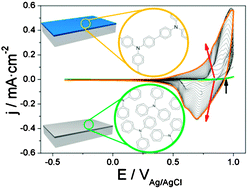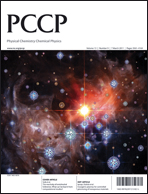Solid-state electropolymerization could be a way to produce organic semiconductors with potential application as Hole Transporting Materials (HTMs) in hybrid organic–inorganic devices. Thereby, thin solid films of triphenylamine (TPA) deposited by spin coating on conducting glass substrates have been electrochemically treated by performing multiple voltammetric cycles between −0.4 V and 1.0 V vs.Ag/AgCl in a 0.5 M sodium perchlorate aqueous electrolyte. Subsequent characterization by means of in situUV-Vis spectroscopy, in situElectrochemical Quartz Crystal Microbalance, Atomic Force Microscopy, Contact Angle analysis, and Open Circuit Potential measurements reveals cross-linking of the monomeric units in the thin film. Such polymerized films are characterized by a high electroactivity linked to doping/undoping, a reversible electrochromic behavior under potentiodynamic conditions and fast changes of the open circuit potential upon illumination, indicating efficient charge transport throughout the film. While extensive polymerization has been demonstrated for TPA, this process is negligible in the case of tri-p-tolylamine, which is linked to the para substitution of the phenyl rings. In more general vein, the feasibility of solid-state electropolymerization is illustrated as well as the potential advantages of this methodology for the preparation of hybrid inorganic/organic materials based on nanoporous oxide matrices.

You have access to this article
 Please wait while we load your content...
Something went wrong. Try again?
Please wait while we load your content...
Something went wrong. Try again?


 Please wait while we load your content...
Please wait while we load your content...